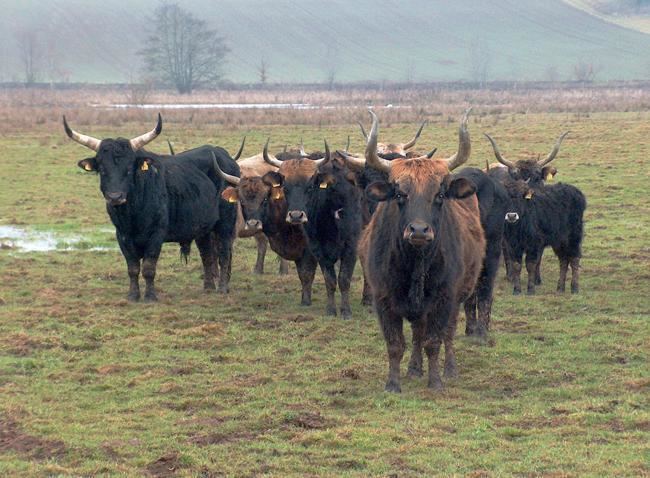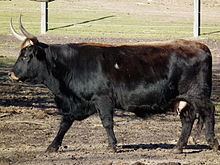Origin Germany | Scientific name Bos taurus Rank Breed | |
 | ||
Weight Male: 600–900 kgFemale: 400–600 kg Height Male: ca. 140 cm;Female: ca. 130 cm; Coat varied shadings of red, brown, black Similar Tux‑Zillertal, Taurus cattle, Sayaguesa, Aure et Saint‑Girons, Dutch Belted | ||
Heck cattle are a hardy breed of domestic cattle. These cattle are the result of an attempt by the Heck brothers to breed back the extinct aurochs from modern aurochs-derived cattle in the 1920s and 1930s. Controversy revolves around methodology and success of the programme. There are considerable differences between Heck cattle and the aurochs in build, height, and body proportions. Furthermore, there are other cattle breeds which resemble their wild ancestors at least as much as Heck cattle.
Contents

Development

Heck cattle originated in Germany in the 1920s and 1930s in an attempt to breed back domestic cattle to their ancestral form: the aurochs (Bos primigenius primigenius). In the first years of the Weimar Republic, the brothers Heinz and Lutz Heck independently started their extensive breeding-back programmes. Their motivation behind that was to rescue the aurochs from oblivion because it was constantly confused with the wisent, the other large bovine of Holocene Europe. The Heck brothers believed that creating a look-alike and showing both species next to each other would help to show the difference between the two species to a broader public. Apart from that, they believed they were able to reconstruct the species and therefore to correct the mistake man made when killing the species off. Heinz was the director of the Hellabrunn Zoological Gardens in Munich and Lutz of the Berlin Zoological Gardens. Only eleven years after they started their breeding experiments, just as the Weimar Republic was drawing to a close, they each announced success. The two brothers used different selections of cattle breeds in their breeding-back attempts. For example, Lutz Heck (in Berlin) used Spanish fighting bulls, while Heinz Heck (in Munich) did not. The Berlin breed seemingly did not survive the Second World War, so all modern Heck cattle go back to the experiments of Heinz Heck in Munich. The ancestral breeds used include:

In 1932, the first bull that Heinz Heck believed to resemble the aurochs, named ″Glachl″, was born. It was a 75% Corsican and 25% (Gray cattle × Lowland × Highland × Angeln) cross individual. This bull and its father subsequently were bred into further breeds to increase weight. As a consequence, most modern Heck cattle go back to Central European milk- and meat cattle that were supplemented by cattle from other regions. Advocates of Heck cattle often claim that Heinz′ and Lutz′ breeding results looked largely identically ″proving the success″ of their experiment. However, Berlin and Munich Heck cattle did not look very similar.

In the German Zoo Duisburg, one Watussi cattle cow, which is a half-zebuine breed, was crossed with a Heck bull. Some modern Heck cattle, mainly those displaying large and thick horns, descend from this crossbred offspring. In some locations, primitive Southern European cattle, such as Sayaguesa Cattle and Chianina, have been crossed into Heck cattle herds aiming to approach the aurochs in phenotypical characters. This cross-breed is called Taurus cattle, which is not to be confused with the Tauros cattle (see below).
Characteristics
A typical Heck bull should be on average 1.4 m (4'5") high and a cow 1.3 m (4'3"), with weight up to 600 kg (1,300 lb). Heck cattle are twenty to thirty centimeters shorter than the aurochs they were bred to resemble. Heck bulls are not much larger than other domestic bulls, while aurochs bulls reached shoulder heights of between 160 and 180, in rare cases even 200, cm. Aurochs bulls are believed to have exceeded weights of between 700 and 1000 kg (2,200 lb).
Size is not the only aspect in which Heck cattle differs from its wild ancestor. Heck cattle are bulky like many other domestic breeds, while the aurochs, as a wild bovine, had an athletic body shape. The legs of Heck cattle are shorter and the trunk much longer than in the aurochs, in which shoulder height and trunk length nearly equalled each other. Heck cattle have a comparably small and short head, while Aurochs had an elongate large head sitting on a muscular neck. Aurochs had a well-developed shoulder musculature, carried by long spines, which is absent in Heck cattle. All in all, proportions and body shape of Heck cattle are not significantly similar to the aurochs and do not differ from many other domestic breeds.
The horns of the aurochs had a characteristic and relatively stable shape. At the base they grew outwards-upwards, then forwards-inwards and inwards-upwards at the tips. Aurochs horns were large and thick overall, reaching 80–100 cm in length and 10 cm or more in diameter. However, the horns of Heck cattle differ in many respects. Usually, they curve too much upwards or outwards compared to the original, or do not reach the length or diameter of the aurochs. Often the horns of Heck cattle strongly resemble the breeds it was created from (f.e. Grey Cattle).
In coat colour Heck cattle may resemble the aurochs, in having bulls with a black overall coat colour with a light eel stripe and cows displaying a reddish-brown colour. However, some Heck bulls may have a light saddle on the back (which was not present in the aurochs) and the sexual dimorphism in color is unclear in most cases; bulls and cows either may have a dark color with a lightly coloured saddle, black cows appear regularly and also lightly colored bulls are no rarity. There are other deviant colours as well, such as individuals having a grayish or gray colour or cows being beige. White patches, typical for pied dairy breeds, do appear as well, sometimes to the same extent as in Holstein cattle.
Heck cattle demonstrate a higher amount of heterogeneity than in any wild animal or most other domestic breeds. There is considerable variation in coat colour, horn shape and horn dimensions, as well as size and proportions. Besides the features that are desired because they bear resemblance to the aurochs, numerous divergent features may appear (as explained above).
Heck cattle differ in many respects from the aurochs, and there are breeds which resemble the aurochs at least as much, such as Spanish fighting bulls, Sayaguesa Cattle, Pajuna Cattle, Maremmana primitivo, and Maronesa. Nevertheless, they are capable of coping in the wild with cold temperatures or nutrient-poor food. On the other hand, there are other robust cattle breeds which cope with harsh conditions at least as well as Heck cattle and feral cattle are no rarity.
Taurus cattle
The ABU (Arbeitsgemeinschaft Biologischer Umweltschutz), a conservation group in Germany, started to crossbreed Heck cattle with southern-European primitive breeds in 1996, with the goal to increase the aurochs-likeness of certain Heck cattle herds. These crossbreeds are called Taurus cattle. It is aimed to bring in aurochs-like features that are supposedly missing in Heck cattle, using Sayaguesa Cattle, Chianina and, to a lesser extent, Spanish Fighting Cattle (Lidia). The same is done in the Hungarian national park Hortobágy National Park, additionally using Hungarian Grey cattle and Watusi, in Lille Vildmose National Park in Denmark, using only Chianina and Sayaguesa so far, and in Latvia.
Controversy
Criticism of the methodology and result of the Heck brother's programs dates back to at least the 1950s. Cis van Vuure describes the work of W. Herre in 1953 and O. Koehler in 1952 who found: "A lack of basic knowledge about the extinct aurochs, broad selection criteria in the breeding-back experiment and the rich imagination and complacency of the two brothers led to their excessive simplification of the breeding-back procedure. Criticism also focused on the carelessness, the ease and the speed with which they had carried out their experiments as well as the genetic basis". Cis van Vuure further states: "On account of the absence of any marked similarity in size, colour and horn shape, among other aspects, Heck cattle cannot be considered to resemble the aurochs closely. Rather they should be seen as a population of cattle in which a few aurochs characteristics may be found; a trait they share with many other cattle populations." In the view of some experts, primitive Southern European cattle breeds are much closer overall to the aurochs than Heck cattle, such as the Spanish fighting bull.
Heck cattle are propagated in some places to fulfill the role of extinct megafauna in the ecosystem. However, European bison supporters claim that Heck cattle landscape management is a public relations ploy in order to illegitimately garner support for Heck cattle at the expense of a genuine native species, the European bison.
Because Heck cattle bear less resemblance to the aurochs than some other modern cattle breeds do, a new back-breeding project, Tauros Programme, has formed in The Netherlands. Using the reconstructed mitochondrial genome of the aurochs, the suitability of hardy primitive breeds - such as Sayaguesa Cattle, Pajuna Cattle or Maremmana primitivo - has been tested, in order to locate the ancient DNA and phenotypic characters in primitive cattle and unite it in one breed that is robust enough to cope in wilderness as much as the aurochs did.
Distribution
There are about 2000 Heck cattle in Europe and few elsewhere. Heck cattle are found in German zoos because of the erroneous claim by the Heck brothers that these cattle represent a resurrected aurochs and are suitable for conservation projects today. In Oostvaardersplassen in Flevoland (Netherlands), about 600 Heck cattle roam freely. Weak animals are shot by hunters in order to prevent unnecessary suffering. Others are at the Falkenthaler Rieselfelder near Berlin, at the Nesseaue nature reserve near Jena, Thuringia and at the Grubenfelder Leonie nature reserve in Auerbach, Bavaria. About 100 were registered in France in 2000. In 2009 nine cows and four bulls were imported to south west England from Belgium. Derek Gow, a British conservationist who operates a rare breeds farm at Lifton in Devon, bought a herd of 13 Heck cattle from Belgium in 2009. The herd grew to 20 animals, but in 2015 Gow had to slaughter all but six due to high levels of aggression.
